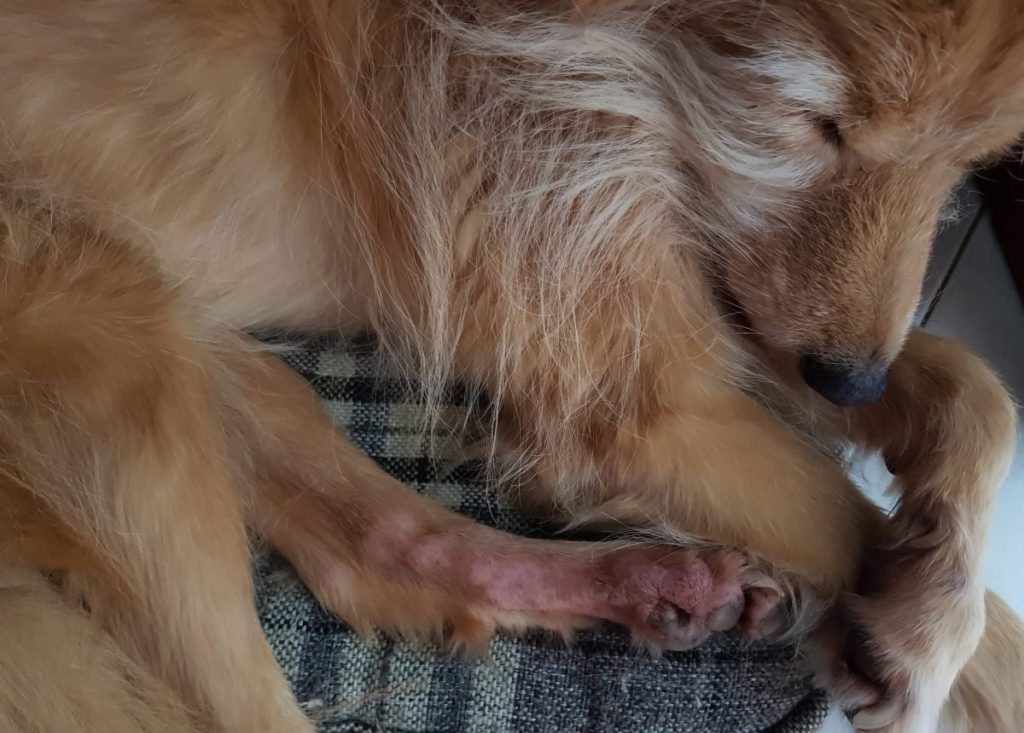Atopic dermatitis (AD) — often simply referred to as atopy — is a chronic inflammatory skin disease in dogs. Similar to eczema in humans, it is one of the most prevalent allergic skin conditions, affecting approximately 10-15% of the canine population. The condition is usually triggered by an overreaction of the dog’s immune system to environmental allergens, which can include pollen, mold spores, dust mites, and even certain foods. These allergens typically penetrate the skin barrier and initiate an immune response that leads to inflammation, itching, and other clinical signs.
Here’s what you should know about the symptoms, causes, and treatments for the condition in dogs.
Symptoms of atopic dermatitis in dogs

Dogs with atopic dermatitis typically start showing symptoms between six months and three years of age. Initially, these signs may be mild but tend to worsen over time as the skin becomes increasingly sensitive. Symptoms can either be widespread across the body or concentrated in specific areas such as the ears, face, feet, armpits, and legs. Additionally, the symptoms may occur seasonally or persist year-round, depending on the allergens involved.
Here are a few signs of atopic dermatitis in dogs that you should look out for:
- Intense itching and scratching
- Red, inflamed skin
- Hair loss (alopecia)
- Scaling or crusting
- Lesions and sores
- Recurring ear infections
- Hyperpigmentation
- Thickened skin
- Licking and chewing
- Rubbing against surfaces
In severe cases, the dog may also exhibit signs of secondary bacterial or yeast infections, which can further complicate the condition.
Causes of atopic dermatitis in dogs

Canine atopic dermatitis is a complex condition influenced by genetic, environmental, and immunologic factors. It is generally accepted that dogs with atopy have a genetic predisposition to developing the disease, which is triggered by exposure to environmental allergens. These allergens can include pollen, dander, mold spores, dust mites, and various other environmental substances.
In affected dogs, the immune system exhibits hypersensitivity to these allergens, resulting in inflammation and intense itching — or pruritus. This immune response leads to the production of immunoglobulin E (IgE) antibodies. Upon repeated exposure to the allergens, these antibodies trigger a cascade of inflammatory reactions involving various immune cells, including mast cells, eosinophils, and T lymphocytes. This process releases inflammatory mediators such as histamines, cytokines, and prostaglandins, which contribute to the clinical manifestations of the disease.
In addition to the immune dysregulation, there is also evidence that dogs with atopic dermatitis have a defective skin barrier. This compromised barrier function allows allergens to penetrate the skin more easily, further exacerbating the inflammatory response. Filaggrin (Flg) — a protein essential for maintaining skin barrier integrity — is often found to be deficient in affected dogs.
Dog breeds most susceptible to atopy
Because atopy is a genetically predisposed condition, certain dog breeds are more susceptible than others. These breeds include:
- Shih Tzus
- Boxers
- Bulldogs
- Jack Russell Terriers
- Pit Bulls
- Golden Retrievers
- Boston Terriers
- Chinese Shar-Peis
- West Highland White Terriers
- Labrador Retrievers
- Weimaraners
- Soft Coated Wheaton Terriers
Although these breeds are more prone to AD, it’s important to remember that any dog can potentially develop the condition. Notably, dogs with both parents affected by atopic dermatitis are at a higher risk, and the disease affects males and females equally.
Treatments for atopic dermatitis in dogs

Before you can effectively treat your dog’s atopy, a proper diagnosis is essential. Atopic dermatitis can often be confused with other skin conditions, so it’s crucial to consult your veterinarian for an accurate diagnosis. Your vet may perform a series of tests, including skin scrapings, blood tests, or allergy tests, to identify the allergens causing the reaction. By pinpointing the exact cause, you can better tailor the treatment to your dog’s specific needs and improve their quality of life.
Once diagnosed, your vet may recommend several treatment options to manage your dog’s symptoms:
Topical treatments
Topical treatments are often the first line of defense in managing canine atopic dermatitis. These treatments aim to soothe the skin, reduce inflammation, and provide immediate relief from itching.
- Medicated shampoos and rinses: Using medicated shampoos containing ingredients like oatmeal, aloe vera, or hydrocortisone can offer relief. You should bathe your dog as per the vet’s recommendation, typically once or twice a week. The frequency of bathing and type of shampoo will depend on the severity of your pet’s condition.
- Topical steroids: Topical corticosteroids can be applied directly to the affected areas to reduce inflammation and itching. However, prolonged use of steroids can have side effects, so follow your vet’s instructions carefully.
- Moisturizers and emollients: These products help in restoring the skin’s natural barrier. Regular application of moisturizers can prevent the skin from drying out and can make your dog more comfortable.
Systemic treatments
When topical therapies aren’t enough, systemic treatments can be very effective. These treatments work internally to manage the condition more comprehensively.
- Oral steroids: Oral corticosteroids — such as prednisone and prednisolone — are often prescribed for severe cases. While effective in reducing inflammation and itching, these medications can have significant side effects like increased thirst, hunger, and long-term complications such as liver damage. Your vet will usually prescribe the lowest effective dose for the shortest duration necessary.
- Antihistamines: Antihistamines can be useful for some dogs, particularly when the condition is mild. Although they may not be effective for all dogs, antihistamines like diphenhydramine — or, more commonly, Benadryl — can help in reducing itching.
- Immunosuppressive drugs: Drugs like cyclosporine can be very beneficial in treating atopy in dogs by suppressing the immune system. These medications can have fewer side effects compared to steroids but often take several weeks to show their full effect.
- Apoquel (Oclacitinib): Apoquel is a newer medication that specifically targets the itching sensation and can provide relief within hours. It is generally well-tolerated and can be used as an alternative to corticosteroids.
- Cytopoint (Lokivetmab): Cytopoint is an injectable treatment that works by neutralizing a specific protein involved in the itching process. The injection can provide relief for four to eight weeks and is a convenient option for long-term management.
Allergen-specific immunotherapy (ASIT)
If your dog has been diagnosed with atopy triggered by specific allergens, allergen-specific immunotherapy (ASIT) can be a highly effective treatment option. This treatment involves gradually exposing your dog to small, controlled amounts of the allergens to build up tolerance over time.
- Allergy testing: Before starting ASIT, your vet will perform allergy testing to identify the specific allergens affecting your dog. This can be done through blood tests or intradermal skin testing.
- Custom formulated injections or drops: Based on the test results, a custom formulation of the allergens will be prepared. This can be administered through injections or oral drops. The treatment protocol typically involves an initial buildup phase followed by a maintenance phase.
- Long-term commitment: ASIT requires a long-term commitment, often several months to a year before significant improvements are seen. However, it can lead to a lasting reduction in symptoms and a better quality of life for your dog.
Dietary and environmental management
Even if your dog’s primary issue isn’t a food allergy, they may benefit from a special diet designed to support overall skin health. Omega-3 and Omega-6 fatty acids — commonly found in fish oil supplements — can help reduce inflammation and improve the skin’s barrier function. Hypoallergenic diets or those formulated for dogs with skin sensitivities can also be helpful. That said, always consult your vet before making any significant changes to your pet’s diet.
Since environmental allergens are a major trigger for AD, managing your dog’s environment is essential. Make sure to frequently clean their bedding, vacuum your home, and use air purifiers to reduce the presence of dust mites, pollen, and mold spores. Additionally, wiping your dog’s paws and coat after outdoor activities can minimize the amount of allergens they bring into your home.
Atopic dermatitis is a lifelong condition that requires consistent management. While it cannot be cured, many dogs can lead comfortable lives with appropriate treatment and management strategies. As such, keep a close eye on your dog’s symptoms and make note of any changes or flare-ups. Most importantly, be sure to schedule regular veterinary check-ups to evaluate your pup’s response to treatment and make necessary adjustments.




